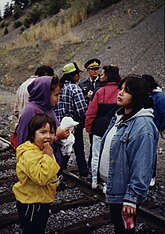216.232.209.134 (talk) No edit summary |
66.131.151.218 (talk) No edit summary |
||
| Line 11: | Line 11: | ||
The standoff escalated as the local natives were joined by indigenous Warriors from across Canada. The Mohawks refused to dismantle their barricade and the Sûreté du Québec established their own blockades to restrict access to Oka and Kanesatake. Other Mohawks at [[Kahnawake]] in solidarity with Kanesatake blockaded the [[Mercier Bridge]] between the [[island of Montreal]] and the South Shore suburbs at the point where it passed through their territory. At the peak of the crisis, the Mercier Bridge and highways [[Quebec provincial highway 132|132]], [[Quebec provincial highway 138|138]] and [[Quebec provincial highway 207|207]] were all blocked. Enormous traffic jams and frayed tempers resulted as the crisis dragged on. |
The standoff escalated as the local natives were joined by indigenous Warriors from across Canada. The Mohawks refused to dismantle their barricade and the Sûreté du Québec established their own blockades to restrict access to Oka and Kanesatake. Other Mohawks at [[Kahnawake]] in solidarity with Kanesatake blockaded the [[Mercier Bridge]] between the [[island of Montreal]] and the South Shore suburbs at the point where it passed through their territory. At the peak of the crisis, the Mercier Bridge and highways [[Quebec provincial highway 132|132]], [[Quebec provincial highway 138|138]] and [[Quebec provincial highway 207|207]] were all blocked. Enormous traffic jams and frayed tempers resulted as the crisis dragged on. |
||
When it was apparent that the Sûreté du Québec and the protestors had reached an [[impasse]], [[Premier of Quebec|Quebec premier]] [[Robert Bourassa]] requisitioned the assistance of the [[Canadian Forces]] in [[Military Aid to the Civil Power |"aid of the civil power"]]. This allowed negotiations to resume, although tension remained high. |
When it was apparent that the Sûreté du Québec and the protestors had reached an [[impasse]], [[Premier of Quebec|Quebec premier]] [[Robert Bourassa]] requisitioned the assistance of the [[Canadian Forces]] in [[Military Aid to the Civil Power |"aid of the civil power"]]. This allowed negotiations to resume, although tension remained high. At some point, the Canadian Forces had to control unrest from fed-up motorists, tired of the daily traffic jams. |
||
On [[September 26]] the barricades were finally dismantled. The golf course expansion, which had originally triggered the standoff, was cancelled. The Oka Crisis eventually precipitated the development of Canada's [http://www.psepc-sppcc.gc.ca/abor_policing/fir_nat_policing_e.asp First Nations Policing Policy]. |
On [[September 26]] the barricades were finally dismantled. The golf course expansion, which had originally triggered the standoff, was cancelled. The Oka Crisis eventually precipitated the development of Canada's [http://www.psepc-sppcc.gc.ca/abor_policing/fir_nat_policing_e.asp First Nations Policing Policy]. |
||
Revision as of 18:59, 10 July 2005
Template:Current Canadian COTW

The Oka Crisis was an event which began on March 11, 1990, and lasted until September 26, near the town of Oka, Quebec.
The crisis developed from a dispute between the town of Oka and the Mohawk reserve of Kanesatake. For some time, the Mohawk nation had been pursuing a land claim which included a burial ground and a sacred grove of birch trees near Kanesatake. This brought them into conflict with the the town of Oka, which was developing plans to expand a golf course onto the disputed land.
As a protest against a court decision which allowed the golf course construction to proceed, some members of the Mohawk community erected a barricade blocking access to the area in question. The barricade stood for three months before the provincial police force (the Sûreté du Québec) intervened on July 11. The police used tear gas and then opened fire in an effort to disperse the Mohawks manning the barricade. Shots were fired in return by Mohawk warriors. The firefight resulted in the death of 31-year-old police officer, Marcel Lemay.
The standoff escalated as the local natives were joined by indigenous Warriors from across Canada. The Mohawks refused to dismantle their barricade and the Sûreté du Québec established their own blockades to restrict access to Oka and Kanesatake. Other Mohawks at Kahnawake in solidarity with Kanesatake blockaded the Mercier Bridge between the island of Montreal and the South Shore suburbs at the point where it passed through their territory. At the peak of the crisis, the Mercier Bridge and highways 132, 138 and 207 were all blocked. Enormous traffic jams and frayed tempers resulted as the crisis dragged on.
When it was apparent that the Sûreté du Québec and the protestors had reached an impasse, Quebec premier Robert Bourassa requisitioned the assistance of the Canadian Forces in "aid of the civil power". This allowed negotiations to resume, although tension remained high. At some point, the Canadian Forces had to control unrest from fed-up motorists, tired of the daily traffic jams.
On September 26 the barricades were finally dismantled. The golf course expansion, which had originally triggered the standoff, was cancelled. The Oka Crisis eventually precipitated the development of Canada's First Nations Policing Policy.